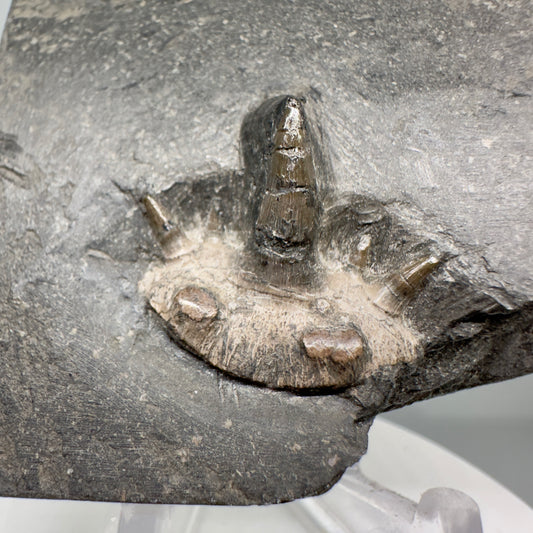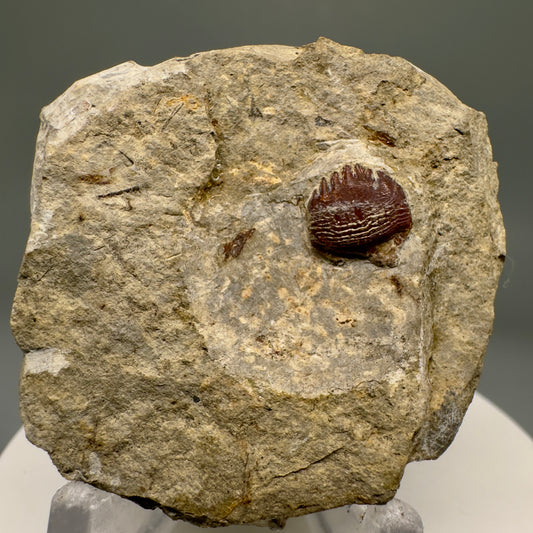About Fossil Shark Teeth
There is now a brand new article that deals with the evolution of the modern Great White Shark (Carcharodon carcharias) and what impact this incredible species has had on shark history. There is also another article dealing with the fossil Carcharocles megalodon sharks that was written for a 1998 issue of Prehistoric Times®. This is a bit more detailed than the previous article which appeared in the September 1997 (Volume 3, Number 9) issue of Fossil News - Journal of Amateur Paleontology® entitled "Megalodon". Just use the links to view them and enjoy!
General Fossil Shark Tooth Information
Since shark skeletons are composed of cartilage instead of bone, often the only parts of the shark to survive as fossils are teeth. Fossil shark teeth date back hundreds of millions of years. The most common, however, are from the Cenozoic Era (65 million years ago to present).
How a Tooth Becomes A Fossil
A tooth become a fossil when it is buried in sediment (or other material) soon after being lost from a shark's mouth. The sediment precludes oxygen and harmful bacteria from reaching the tooth and destroying it. The general fossilization process varies greatly depending on the exact situation. In general it takes approximately 10,000 years for a tooth to become a true fossil.Why Fossil Teeth Are Different Colors
The color of a tooth is determined solely by the color of sediment in which it is buried while fossilizing. The tooth absorbs minerals from the surrounding sediment. As the minerals replace the natural structure of the tooth, the tooth becomes the same general color as the sediment. Therefore, color is not an effective indicator of the age of a tooth. The most common color for shark teeth is a black root with a grayish crown. Different colors are more uncommon and significantly increase the value of a tooth.Shark Teeth in our Catalog and History of the megalodon
Where the Teeth are Found and How Old They Are
The majority of the teeth we offer for sale in this catalog are from the Miocene-Pliocene Epochs (approximately 24.5 million to 2 million years ago). During this time period oceans sporadically covered many parts of what is now the Southeastern United States. For this reason many of the megalodon teeth we have to offer come from either South Carolina/Georgia rivers (which cut through the fossil-rich Hawthorne Formation), South Florida phosphate mining operations (which unearth fossils from the Bone Valley Formation), or from the fossil ledges found offshore of Wilmington, NC. Most of the teeth from these locations are between 3 and 10 million years old.
History of the Carcharocles megalodon Shark
We specialize in teeth from the Carcharocles megalodon shark which thrived during the above time period. This shark was the largest shark to ever swim the ocean. Reaching an overall maximum length of approximately 60 feet, this shark was three times the size of the modern Great White (Carcharodon carcharias) shark.
Carcharocles megalodon Teeth and What Makes Them So Valuable
The teeth from the megalodon shark are truly massive in both length and width. The largest teeth are as large as a man's hand and can weigh well over a pound. The largest complete megalodon tooth ever found measures just over 7" in slant height (measure of the longest side from tip of tooth to the top of the root). Teeth this size, however, are extremely rare. There are only a few teeth in the world that measure over 7" legitimately (however there have been lots of "stretched fakes" so be careful what you buy!!). Smaller teeth are much more common with the average size being about 3 1/2" - 4 1/2" in slant height. Teeth over 5" are more uncommon and over 6" can be quite rare, so the value of teeth this size is significantly greater than the smaller ones.
Another factor that greatly increases the value of a tooth is the degree of preservation. The vast majority of teeth that have become fossils have been destroyed by natural processes (erosion, chemical processes, etc.). Most megalodon teeth found have undergone quite a bit of destruction, with chunks of the tooth broken off, the enamel eaten through, or significant erosion wearing the natural features of the tooth. Occasionally, one comes across a perfectly preserved tooth still bearing its original features and sheen. While uncommon, teeth like this are found and are of significant value. We try to concentrate on these more perfect teeth, although we do have teeth for sale with minor erosion (worn serrations, etc.) for those who just want to own a nice piece of history at a significantly lower price. We carry teeth of all grades in our inventory but typically only show the higher quality teeth individually in the catalogs and throughout the pages on this Site. Other teeth are available for bulk purchase at a wholesale rate.
-Steve
Frequently Asked Questions (FAQs) - Megalodon Fossil Teeth
General Questions About Megalodon (and other sharks) Fossil Teeth
1. Are your Fossil Shark teeth real?
Yes! Every Megalodon and other fossil shark tooth we sell is 100% authentic. Each specimen is carefully sourced and comes with detailed information on its size, condition, and location of discovery.
2. Where do your Shark teeth come from?
We source our fossilized Shark teeth from some of the most famous fossil locations, including:
- North Carolina Ocean & South Carolina blackwater rivers
- Bone Valley, Florida
- Georgia, California
- Southeast Asia
- South America
- Europe
3. How do I know if a fossil shark tooth is valuable?
The value of a fossilized shark tooth depends on several factors:
• Size – Larger teeth (especially over 5 inches for Megalodon) are more valuable.
• Condition – Well-preserved enamel, root, and serrations increase value.
• Color – Unique colors like black, blue, and red are highly collectible.
• Rarity – Obscure species like Bramble, Cow Shark, and Edestus are more difficult to find.
4. What does “restored” or “repaired” mean for a fossil shark tooth?
• Restored: Small areas have been reconstructed for aesthetic enhancement.
• Repaired: The original fossil was broken and has been professionally reattached.
We ALWAYS fully disclose any restoration or repairs in our product descriptions if they apply. 99% of what we sell will be completely natural without any repair or restoration so it will not be mentioned in the descriptions.
Buying & Shipping Fossil Shark Teeth
5. Do you offer international shipping for fossil shark teeth?
Yes! We ship authentic fossil shark teeth worldwide (with only a few exceptions). However, customs regulations vary, so please check your country’s import rules before purchasing. Any duties/taxes/tariffs are the buyer's responsibility as we have no control over these fees.
6. How long does shipping take?
• U.S. Orders: 2–7 business days.
• International Orders: Delivery times vary by country and method of shipping. Anywhere from 2 days to 4-5 weeks.
7. What is your return policy?
We accept returns within 14 days of delivery, as long as the item is in its original condition. The buyer is responsible for return shipping costs.
Collecting & Caring for Fossilized Shark Teeth
8. How should I care for my fossil shark tooth?
To maintain the condition of your fossilized shark tooth:
• Store it in a dry, cool place, away from direct sunlight.
• Avoid exposure to water, chemicals, or extreme humidity.
• Use a display case or protective stand for long-term preservation.
9. How can I tell if a fossil shark tooth has been restored?
Look for differences in texture, sheen, or color variations. Professional restorations are often seamless and difficult to spot unless you've seen 100's of examples. We always disclose any repairs or modifications.
10. Do you buy fossil shark teeth?
Yes! We are always looking for fossilized shark tooth collections. If you have authentic fossil shark teeth for sale, contact us with photos and details. No collection is too large.
Gift Cards & Wholesale Fossil Shark Teeth
13. Do you sell gift cards for fossil collectors?
Yes! Our electronic gift cards are available in multiple denominations and never expire. They make the perfect gift for any fossil collector, paleontology enthusiast, or shark tooth hunter.
14. Do you offer wholesale fossil shark teeth?
Yes! We provide wholesale prices and quantities of fossil shark teeth to:
• Retail stores & museums
• Fossil shops & online resellers
• Educational institutions
Contact us for bulk pricing and availability.
Why Buy from MegalodonTeeth.com?
At megalodonteeth.com, we are passionate about providing authentic fossil shark teeth, ranging from megalodon giants to rare prehistoric species. Browse our collection today and own a genuine piece of prehistoric history!
Everything 20% OFF
-
Brown, Extra Large 6.05" Fossil Megalodon Tooth: Scuba Diving, USA
Regular price $479.20 USDRegular priceUnit price / per$599.00 USDSale price $479.20 USD
Length : 6.05"
Location: Southeast, USASale -
Very Rare 300 years old 0.83" in Matrix Fossil Cladodus sp. Shark Tooth - Nebraska
Species: Cladodus sp.Regular price $319.20 USDRegular priceUnit price / per$399.00 USDSale price $319.20 USD
Length: 0.83"
Location: Cass County, NebraskaSale -
In Matrix Fossil Petalodus frederixi - Extinct Petalodont Tooth - Russia
Species: Petalodus frederixiRegular price $239.20 USDRegular priceUnit price / per$299.00 USDSale price $239.20 USD
Width: 0.36"
Location: RussiaSale -
Large, Colorful 2.98" serrated Fossil Carcharocles angustidens Shark Tooth from Summerville, South Carolina
C. angustidensRegular price $239.20 USDRegular priceUnit price / per$299.00 USDSale price $239.20 USD
Length : 2.98"
Location: Summerville, SCSale -
Spectacular, large 3.24" Serrated Fossil Carcharocles angustidens Shark Tooth - South Carolina
C. angustidensRegular price $199.20 USDRegular priceUnit price / per$249.00 USDSale price $199.20 USD
Length : 3.24"
Location: Wando River, South CarolinaSale










